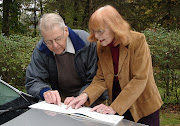When you receive your ILL (Interlibrary Loan) book have you ever wondered what the book's home library looked like and where it was located? Phyllis Bogert has!
Beginning in 2001, she and her husband have packed lunch, mapped out the route and taken many excursions to photograph these libraries while enjoying the beautiful Berkshire scenery and attractions along the way.
Their expeditions (covering 8-10 libraries at a trip) were so much fun that they expanded to the central Massachusetts libraries. Now they have covered most of Connecticut and Rhode Island libraries as well as some in New Hampshire and Vermont. It is an ongoing process as libraries upgrade, add additions and build new libraries.

WMRLS headquarters are located in a low sprawling building on a former tobacco field just below Mt. Sugarloaf in Deerfield, MA. Here the vans bring their bins of books collected on their daily runs. During the night this cargo is sorted into various outgoing bins, loaded on the vans and then distributed to eager patrons at the receiving libraries during the next day or two. The vans travel to the New York, Connecticut, and Vermont borders covering Berkshire, Franklin, Hampshire and Hampden counties.
Here are some interesting facts about the libraries:
Savoy library is located in a closet at the town hall.
Mt. Washington library consists of stacks at one end of the town hall (which is reached by a dirt road).
Andrew Carnegie library funds were accepted by 15 towns in Massachusetts in the first decade of the 20th century. Springfield received the largest donation--$260,000. Other western Massachusetts libraries receiving grants were Granby, Lee, New Marlboro, South Hadley, Turners Falls and West Springfield.
The Bryant Free Library in Cummington was funded by William Cullen Bryant, the poet, who was born there.
Beginning in 2001, she and her husband have packed lunch, mapped out the route and taken many excursions to photograph these libraries while enjoying the beautiful Berkshire scenery and attractions along the way.
Their expeditions (covering 8-10 libraries at a trip) were so much fun that they expanded to the central Massachusetts libraries. Now they have covered most of Connecticut and Rhode Island libraries as well as some in New Hampshire and Vermont. It is an ongoing process as libraries upgrade, add additions and build new libraries.

WMRLS headquarters are located in a low sprawling building on a former tobacco field just below Mt. Sugarloaf in Deerfield, MA. Here the vans bring their bins of books collected on their daily runs. During the night this cargo is sorted into various outgoing bins, loaded on the vans and then distributed to eager patrons at the receiving libraries during the next day or two. The vans travel to the New York, Connecticut, and Vermont borders covering Berkshire, Franklin, Hampshire and Hampden counties.
Here are some interesting facts about the libraries:
Savoy library is located in a closet at the town hall.
Mt. Washington library consists of stacks at one end of the town hall (which is reached by a dirt road).
Andrew Carnegie library funds were accepted by 15 towns in Massachusetts in the first decade of the 20th century. Springfield received the largest donation--$260,000. Other western Massachusetts libraries receiving grants were Granby, Lee, New Marlboro, South Hadley, Turners Falls and West Springfield.
The Bryant Free Library in Cummington was funded by William Cullen Bryant, the poet, who was born there.
+of+image-33.jpg)
Marshall Field grew up in Conway and in 1901 built that library as a memorial to his parents. With its rotunda of imported marble, it is a miniature of the Field Museum in Chicago.
Henry Hobson Richardson designed libraries with low, arched entrances and high, banked windows to allow for book stacks to be placed along the walls. These arches are seen at the Belchertown and Sixteen Acres libraries.
Longmeadow's library was built in 1932 and enlarged in 1992. The original library is now the house behind the current library which was the remodelled barn of the Storrs parsonage, now the Longmeadow Historical Society building.
+of+image-5.jpg) The Belchertown Library is built of local stone and has stained glass windows made from western Massachusetts sand and silica minerals. Soft, classical music within lends a church-like atmosphere.
The Belchertown Library is built of local stone and has stained glass windows made from western Massachusetts sand and silica minerals. Soft, classical music within lends a church-like atmosphere.
Now, scroll up to the slide show at the top of the post and enjoy a pictorial journey to these diverse architectural storehouses--large and tiny, magnificent and plain--that contribute to our joy of learning.
Longmeadow's library was built in 1932 and enlarged in 1992. The original library is now the house behind the current library which was the remodelled barn of the Storrs parsonage, now the Longmeadow Historical Society building.
+of+image-5.jpg) The Belchertown Library is built of local stone and has stained glass windows made from western Massachusetts sand and silica minerals. Soft, classical music within lends a church-like atmosphere.
The Belchertown Library is built of local stone and has stained glass windows made from western Massachusetts sand and silica minerals. Soft, classical music within lends a church-like atmosphere.Now, scroll up to the slide show at the top of the post and enjoy a pictorial journey to these diverse architectural storehouses--large and tiny, magnificent and plain--that contribute to our joy of learning.
